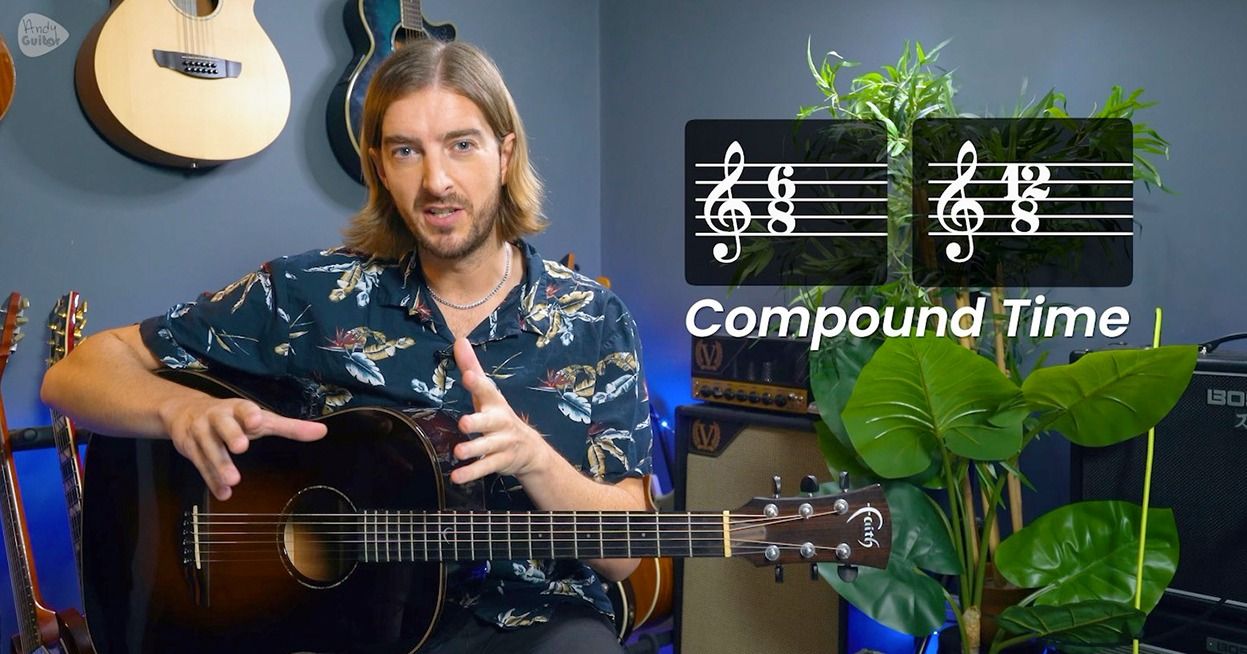3:4, 6:8 and 12:8 Time Explained
Course: Fingerstyle Introduction, Minor keys and the A Minor Pentatonic Scale

In this video
I'm going to show you everything you need to know about Compound Time Signatures. These include 6/8 and 12/8 time.
So many songs that we'll ever learn and have learnt so far are in the time signature 4/4:
4 beats to the bar
The beats are 1/4 (quarter) beats
Top Number: Number of beats
Bottom Number: How long the beat is
Top songs NOT in 4/4!
Tennessee Whiskey by Chris Stapleton, Hallelujah, House of the Rising Sun, Lover by Taylor swift, Everybody Hurts by R.E.M
Some (like 12/8 time) CAN be counted as 4 beats to the bar, but all have some form of triplet feel, understood by everyone as a “waltz feel”, or a count of 3
Strumming Recap and Top tips
Can’t get a rhythm?: Clap and count rhythms in different time signatures to internalise the beat.
Off beats: Struggle with more syncopated rhythms with more up strums than down strums? Try doing reggae style off beat only patterns; I’m Yours or Natural Mystic
Don’t strum all the strings all the time: Thicker on the down, thin on the up, accents on 2 and 4
Twist the wrist: Strumming should feel like 'shaking your hand out' as a motion
Muting and dynamics : Strumming sounding stale? Add muting, dynamics and 16th embellishments to give it life!
Understanding Time Signatures
Basics of Compound Time Signatures:
3/4 - Has a Waltz Time feel, but to be in 3/4, the song should change chord or have a very strong beat on 1 of 3 - Song example: Mr Bojangles
6/8 - counted as 1-2-3, 1-2-3 or 1-2-3-4-5-6 with a strong accent on the "1" - Song example: Hallelujah, House of the Rising Sun, Lover by Taylor swift
12/8 allows for a lot of rhythmic flexibility and complexity.
12:8 is counted - 1-&-a, 2-&-a, 3-&-a, 4-&-a
Songs in 3/4, 6/8, and 12/8 time signatures might seem similar because they all can be counted with a sort of "waltz" feel, but they differ significantly in how they are phrased, felt, and played. Which time signature exactly is mostly on the chord change.
As a default, saying something is in 6:8 is rarely wrong, 3:4 is never used for guitar songs, and 12:8 is most common when theres a full count of 4 for a single chord
6/8 Time Signature
6/8 - counted as 1-2-3, 1-2-3
Strong accent on the "1"
Song example: Hallelujah, House of the Rising Sun, Lover by Taylor swift
12/8 Time Signature
Structure: Typically, 12/8 is counted as four beats per measure, with each beat divided into three sub-beats (1-&-a, 2-&-a, 3-&-a, 4-&-a). It combines the feel of 4/4 time with the rhythmic subdivision of triplets
Feel: 12/8 allows for a lot of rhythmic flexibility and complexity. It’s often used in blues and jazz to provide a smooth, swinging feel that’s much looser than 3/4 or 6/8, offering a laid-back, relaxed groove
Examples: Tennessee Whiskey by Chris Stapleton, Gravity by John Mayer and Everybody Hurts by R.E.M
Comparison and Musical Impact
While 3/4, 6/8, and 12/8 might each have a triplet feel, the way they are counted and where the accents fall make them suitable for different types of music. The choice of time signature affects the overall feel, rhythm, and flow of a song
In composition, choosing between these time signatures depends on the musical context and the emotional effect the composer wants to achieve. Each brings a different type of rhythmic movement and energy, impacting how a piece is perceived and experienced by listeners
Basics of Time Signatures to finish:
Common time signatures: 4/4, 3/4, 6/8 and 12/8
First number is how many, 2nd number is how LONG is the beat
4/4 - Most songs!
3/4 - ‘Waltz time’ not used much - Song example: Mr Bojangles
6/8 - Counted as - 1-2-3, 1-2-3 or 1 - 2 - 3 - 4 - 5 - 6 Song examples: Hallelujah, House of the Rising Sun
12/8 - Counted as - 1-&-a, 2-&-a, 3-&-a, 4-&-a Song examples: Tennessee Whiskey by Chris Stapleton, Gravity by John Mayer, Everybody Hurts by R.E.M
Course Outline
Fingerstyle Introduction, Minor keys and the A Minor Pentatonic Scale
